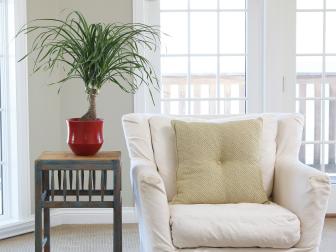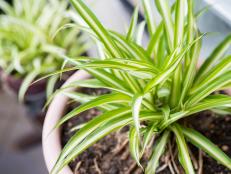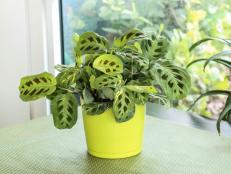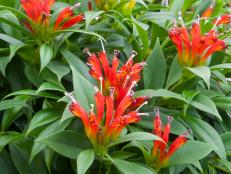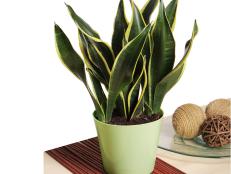How to Grow and Care for Peperomia Plant
Grow easy-to-love peperomia, favored for its foliage in a wide range of color and forms. We'll show you how to successfully care for this tropical beauty.
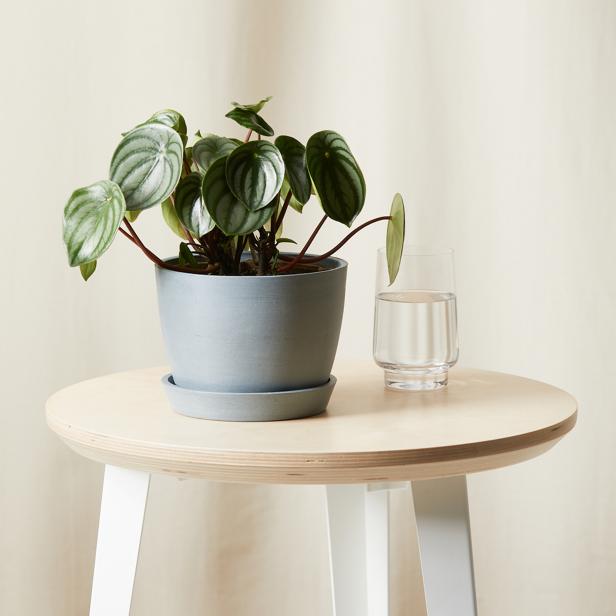
Bloomscape
Watermelon peperomia is named for its leaves, which resemble watermelon rinds.

The search for the perfect indoor plant can be cumbersome. Especially for beginners to the houseplant game, care instructions are sometimes confusing. It helps to choose a plant that will forgive your missteps and adapt to varied conditions. Whether this struggle sounds familiar, or you are a seasoned plant collector searching for your next specimen, peperomia is likely to be a great match.
The National Garden Bureau has named 2022 the Year of the Peperomia, and for good reason: This plant family is versatile, uniquely beautiful and easy to love.
The peperomia genus includes more than 1,000 species, native mainly to South America, with some species from Africa and the Caribbean. Peperomia is closely related to Piper nigrum, the source of black pepper (although peperomia is not edible). All species are herbaceous, compact evergreens — some bushy and some vining. Peperomia are notable for their ornamental and textural foliage, with a wide range of color and form available to discover.
In nature, peperomia are epiphytic; they dwell in the treetops to access brighter light, anchoring in decomposing branches and pockets of leaf litter. Mimicking these natural conditions, peperomia thrive in well-draining soil, bright but indirect light and soil that dries between waterings. However, peperomia are adaptable to average indoor conditions and will tolerate lower light. Read on to explore eight popular types of peperomia, and learn to care for them effectively.
8 Popular Types of Peperomia
While there are many species of peperomia in the wild, the following eight are available, reliable houseplants. With countless options of leaf shape, color and variegation, collecting cultivars can become addictive.
Most peperomia produce cream-colored spiked inflorescences, which add dynamic texture. Thanks to their small size, peperomia can be used decoratively even in petite spaces. Explore upright varieties (the first five listed) to place on desks and tables. Try vining types (the last three listed) for hanging baskets or trailing from a tall shelf. All peperomia do well in dish gardens and terrariums.
Emerald Ripple Peperomia
Botanical Name: Peperomia caperata
Other Common Names: Ripple Peperomia
Notable Varieties: Rosso, Red Ripple, Silver Ripple, Frost, Quito
The popular ripple peperomia earns its name from the deeply furrowed surface of its broad, heart-shaped leaves. This upright species forms a tidy rosette of leaves not exceeding an 8-inch spread. With dozens of differently colored cultivars, ripple peperomia can suit most any palette and has unique textural interest. The 'Rosso' variety is coveted, sporting longer, pointed emerald leaves with rich burgundy undersides.
Watermelon Peperomia
Botanical Name: Peperomia argyreia
Other Common Names: Watermelon Begonia, Watermelon Leaf Plant
Notable Variety: Harmony's Gold Dust
The peltate leaves of watermelon peperomia feature silvery white streaks across their green surfaces, mimicking watermelon stripes. With a bushy, rosette habit similar in scale to emerald ripple, this peperomia is another smart choice for small spaces. While the streaks can give a similar visual effect to the ripples of P. caperata, watermelon peperomia are differentiated by their smooth leaf surface. This species is sometimes called watermelon begonia, but it is not related to begonias.
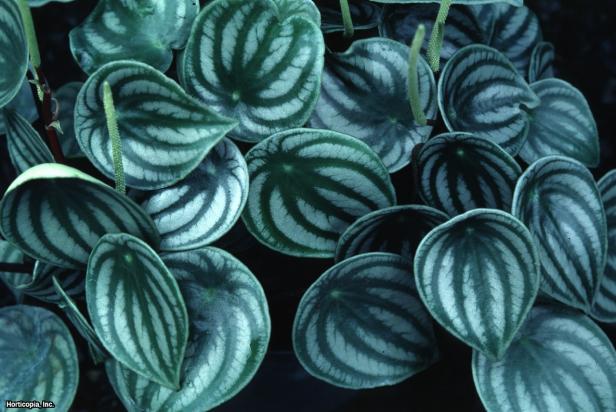
Peperomia argyreia
Raindrop Peperomia
Botanical Name: Peperomia polybotrya
Other Common Names: Raindrop Plant
The shiny emerald leaves of raindrop peperomia are unique in their teardrop shape, nodding elegantly from the central stem. There is a slight dip in each peltate leaf where it attaches to the petiole, and this shallow cup catches and reflects light beautifully. Raindrop plants are petite and upright, similar to ripple and watermelon peperomia.
Oval Leaf Peperomia
Botanical Name: Peperomia obtusifolia
Other Common Names: Baby Rubber Plant, Pepper Face
Notable Variety: Variegata
With its succulent-like leaves and perky sense of presence, oval leaf peperomia is another popular pick. Likened to the rubber plant (Ficus elastica), this species is similar in appearance but shrunken in scale, with glossy, obovate leaves typically 2-4 inches long. This upright peperomia is more branching than those aforementioned, and may gradually grow 18-24 inches tall and wide. The artful cultivar 'Variegata' features a bicolor blend of soft green and creamy white.
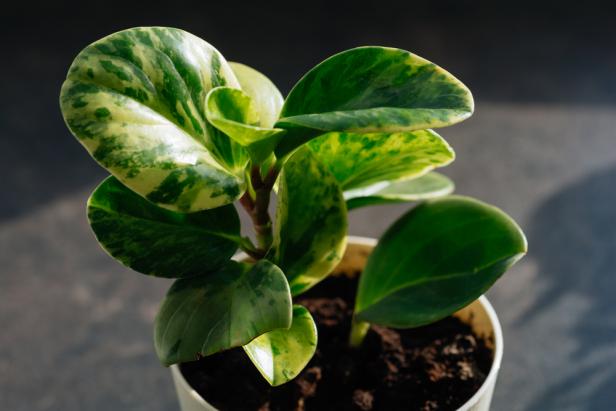
Shutterstock/awindrunner
Peperomia obtusifolia
Red Edge Peperomia
Botanical Name: Peperomia clusiifolia
Other Common Names: Peperomia Ginny or Jelly
Notable Variety: Tricolor
The fleshy, obovate leaves of this Jamaican species are outlined in red. The 'Tricolor' variety is especially striking — its abstract variegation of cream, green and deep pink creating an almost water-colored impression. This compact, upright houseplant reaches around 6-8 inches tall and makes a delightful decor element.
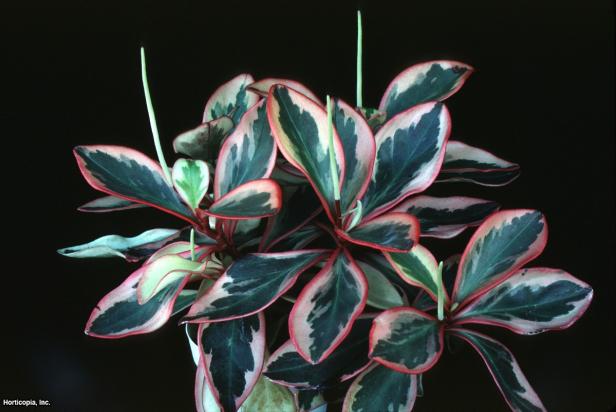
Peperomia clusiifolia
String of Turtles
Botanical Name: Peperomia prostrata
Other Common Names: Trailing Peperomia, Turtle Vine
This unique trailing peperomia features fleshy, tiny, rounded leaves that have a chocolate mottling pattern — almost like little turtle shells. While this vine spreads actively, it is not aggressive, so it can be paired with other plants with similar preferences.
Trailing Jade
Botanical Name: Peperomia rotundifolia
Other Common Names: Round Leaf Peperomia, Jade Necklace, Yorba Linda,
Creeping Buttons
Notable Variety: Ruby Cascade
This vining peperomia has slightly rounder, flatter leaves than string of turtles, but it is otherwise similar (minus the mottling pattern). The variety 'Ruby Cascade' features verdant leaves with crimson undersides, lending particular ornamental interest.
Peperomia 'Hope'
Botanical Name: Peperomia tetraphylla
Other Common Names: Round Leaf Peperomia
Notable Varieties: Hope
Hope peperomia has succulent-like, vibrantly green, rounded leaves with subtle lime-green streaks and reddish stems. Hope is a hybrid of the species P. deppeana and P. quadrifolia. This is a low-growing, vining type of peperomia, with a maximum height and spread of around 10 inches. Its leaves are thicker than string of turtles and trailing jade, although it fills a similar niche.
Peperomia Care
Where to Put Peperomia
Peperomia have historically been called "radiator plants" because they tend to thrive in the ambient warmth and indirect sunlight typically found on top of radiators. In reality, peperomia can find happiness in many parts of the home or office.
30 Indoor Plants for Low Light 31 Photos
These houseplants, including peperomia, are perfect for homes and offices with little or no natural sunlight.
Medium brightness from an indirect source of light is ideal; think sunlight filtering through a curtain for most of the day. However, peperomia will tolerate lower lighting (for example, over winter when sun angles change). They can also thrive in the fluorescent light of office or shop spaces. Avoid placing peperomias in drafty areas; they enjoy steady temperatures of 65-75 degrees.
Brightly colored and variegated leaves may lose contrast and vibrancy in lower light. If leaves appear bleached or faded, they are likely receiving too much direct sun.
Planting Peperomia
Peperomia requires a highly porous, well-draining potting mix that absorbs moisture evenly and dries between waterings. To encourage air flow, peperomias perform best in clay pots. Select a pot that just fits the size of the rootball. These small, slow-growing plants actually enjoy being pot-bound, so repotting is only needed every two or three years.
Watering Peperomia
Establish a routine of watering peperomias every 1-2 weeks, waiting until the top 2 inches of soil feel dry. The good news is, even if you are forgetful, peperomia will likely forgive a few weeks of neglect. If the leaves appear wilted or start to drop, feel the potting soil; if it's dry, underwatering is the problem, and if it's wet, overwatering is to blame.
Bottom watering is a smart method for any houseplant, helping the roots readily absorb water. Use dishes under each pot or place your collection of peperomia in a tray for watering. To bottom water, fill the dish with about 1/2 inch of water and let the plants absorb it. If the water gets absorbed and the top layer of soil is still dry, add more water. If the soil becomes saturated with water still standing, tip remaining water out of the tray to allow proper drainage. While many tropical plants thrive with frequent misting, this isn't required for peperomia as they are adapted to drier conditions as epiphytes (however, humidity can't hurt).
Fertilizing Peperomia
Peperomia do not require much fertilization. University of Wisconsin - Madison's Cooperative Extension recommends applying fertilizer twice annually at a lower dose than the recommended application rate. Select an organic fertilizer that is labeled specifically for houseplants. There is anecdotal evidence that peperomia types with colorfully variegated foliage hold their color better with more fertilizer, so you may want to experiment with quarterly or slightly stronger applications for colorful cultivars in addition to offering these cultivars slightly brighter light. Only fertilize during spring or summer, as these are active growth periods.
Peperomia Pests
Peperomia plants are relatively disease-free, but mealybugs may become an issue. Cornell Cooperative Extension recommends hand-picking the bugs off the plants in their crawling stage. Use a cotton swab or soft cloth, dipped in rubbing alcohol or diluted dish detergent, to remove them. Garden centers carry a range of organic products to manage such pests; look for products labeled specifically for mealybugs, like neem oil and Safer soap. Always follow application instructions precisely.
Peperomia Winter Maintenance
During winter, water less frequently as peperomia grow very slowly. Make sure plants are safe from cold drafts or aggressive heat vents.
Peperomia Summer Care
Tropical houseplants revel in exposure to summer's humid warmth. Move peperomias outdoors for at least part of the summer to give them a taste of their native conditions and to spur growth during their active season. While outdoors, peperomia prefer deep to part shade. Trailing varieties make nice hanging basket plants for shaded porches.
Propagating Peperomia
Arguably the best thing about a robust indoor plant collection is the opportunity to propagate, generating free plants to expand your collection or gift to other green thumbs. Peperomia are easy to propagate from leaf petiole or stem cuttings.
To root a leaf petiole cutting, insert the cut end into a moist rooting mix with the leaf standing upright; you can layer several leaves this way. Make your own rooting mix by combining one part sand or perlite with one part peat moss; this mix provides a porous environment for healthy root growth. Once the cuttings root, they may be potted up individually.
Peperomia and Pets
In addition to its ornamental value and ease of care, peperomia has the distinct advantage of being pet-friendly. Peperomia are listed as non-toxic to dogs and cats by the ASPCA, so enjoy these beautiful plants indoors without worry.






